A united front against Russia: The Sapporo agreement
isolate Putin


A united front against Russia: The Sapporo agreement
isolate Putin

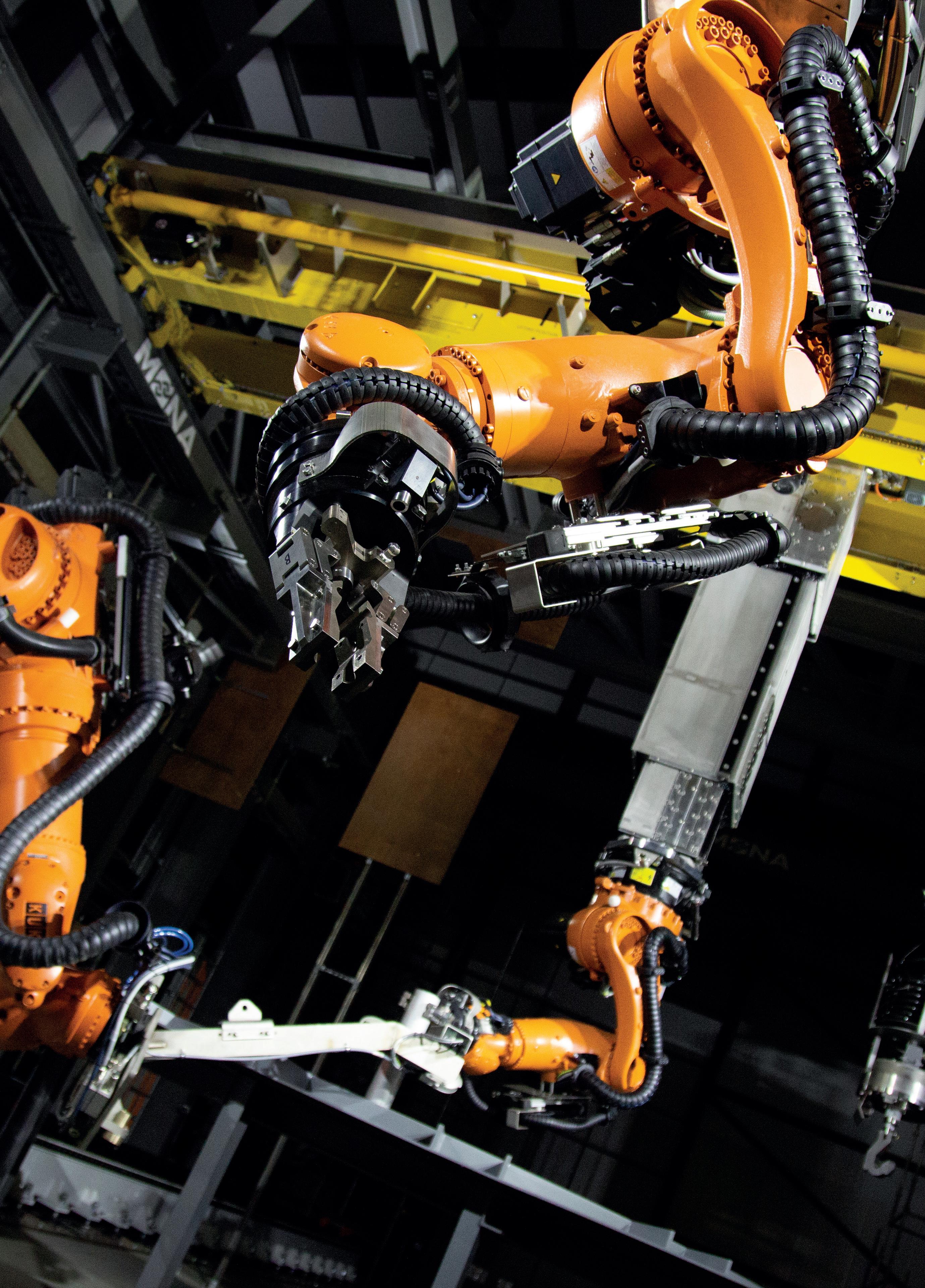
Welcome to the Summer edition of Industry Link! It’s been a busy few months, not least for our existing fleet of stations, which, as I write this, are generating close to a quarter of Britain’s electricity. All from a land footprint of 0.57 square miles. Not bad for five stations… But imagine what we could do if we built more. Even more clean power, better energy security and, of course, more great jobs.
These are often the top three reasons which gives nuclear a strong appeal, which also proved popular in a recent YouGov poll commissioned by the NIA. The poll, which you can read all about in this issue, shows that public support for nuclear is growing, which the sector as a whole deserves a pat on the back for.

Ensuring people are fully aware of the social value of nuclear is vital to grow that support, but how do we maximise and measure that?
Well, you’re in luck, Costain’s Jeremy Galpin and Andrea Noblett explain just that.
There’s also an international feel to this edition, with Germany turning off its last remaining three reactors analysed by the NIA’s Lincoln Hill; Tom Greatrex takes us to Japan where nuclear was centre stage at the G7 Ministers’ meeting on energy; and UK Atomics a subsidiary of Denmark’s Copenhagen Atomics explain why its waste burner reactor could be a gamechanger in advanced nuclear.
We’re also very excited to be profiling the industry’s Apprentice of the Year, Grace McCrickard, who beat hundreds of nominees to win not one but two awards at this year’s NSAN Awards. We hope you enjoy!

 Iolo James Head of Communications, Editor
Editor - Iolo James
Art Editor - Dan Powney
Iolo James Head of Communications, Editor
Editor - Iolo James
Art Editor - Dan Powney
Press & Advertisement Enquiries - press@niauk.org
Membership Enquiries - membership@niauk.org
Contributors - Tom Greatrex • Lincoln Hill • Leia
Mouchous • Michael Drury, UK Atomics • Jeremy Galpin & Andrea Noblett, Costain • Elliw Williams, Cwmni Egino
• Grace McCrickland, JF Nuclear • with additional thanks to World Nuclear News
Nuclear Industry Association is a company limited by guarantee registered in England No. 2804518
Registered Office - 5th Floor, Tower House, 10 Southampton Street, London WC2E 7HA
TEL +44(0)20 7766 6640
EMAIL info@niauk.org
Cover image - Courtesy of UK Atomics https://ukatomics.com

The G7 Energy Ministers meeting, which took place in Sapporo in the northern most Japanese island of Hokkaido in April was unsurprisingly focussed primarily on issues of energy security, co-operation and resilience in a world where the impact of Russian aggression in Ukraine has been felt most keenly on the energy markets.
While last winter the UK managed to get through thanks to a combination of good fortune with relatively mild weather and billions of pounds spent on support for consumers energy bills, it is apparent to all that eventually luck runs out and it would be economically ruinous to have to subsidise market power prices to such an extent in perpetuity. Similar pressures have been felt across the G7 nations to varying degrees, and the geopolitical context has pushed leading economies closer in collaborating on an effective response that ensures resilience and reliability.
Of course, it should be of no surprise to anybody reading this that collaboration on nuclear power helps to provide a significant part of the answer in a climate friendly way high amounts of sovereign power, with no carbon emissions, and predictable long term pricing.
A dose of reality over the past eighteen months have helped governments realise that not only does nuclear have an integral role to play, taking an active approach will deliver more at a faster rate and provide economic benefits. That is why we have seen the UK, USA and Canada reinvigorate their nuclear policies to be at the forefront of development of small modular reactors with a global reach; France approve plans to deliver new reactors ready to replace the oldest of their current fleet; and Japan re-starting more of the power stations mothballed since the Fukushima tidal wave. We are seeing accelerating plans for nuclear capacity in central and Eastern Europe, a reversal of anti-nuclear policy in South Korea and the debate over the potential of civil nuclear in Australia.
For the first time ever, at the G7 Energy Ministers meeting, there was a nuclear energy forum organised by our counterparts in the USA (NEI) and Japan (JAIF), with support from ourselves, CNA (Canada), nucleareurope (EU), and the World Nuclear Association and attended by Ministers from the UK, USA, Canada, Japan and France. While side events at global gatherings are not unusual, to have one
that both attracted the interest, involvement and attendance of so many Ministers is not the norm. Senior leaders from competitor companies across the nuclear fuel cycle and supply chain in each of our countries were able to illustrate both the impetus and appetite for an unprecedented level of international collaboration to help deliver the capacity needed for a sustainable and resilient future power market, reducing the reliance on fossil fuels, including those originating in Russia. Or as Jennifer Granholm, the US Energy Secretary, referred to it in Saporro collaborative effort.
While nuclear power is uniquely able to offer resilience and energy security alongside constant, reliable supply and without harmful emissions when generating power, there is one area of the equation where Russia continues to have a significant foothold in fuel supply. That is why G7 Ministers in Sapporo agreed a communique that both included a commitment to working more closely together on civil nuclear power and an agreement to counter Russia’s role in global nuclear energy by “leveraging the respective resources and capabilities of each country’s civil nuclear power sectors to undermine Russia’s grip on supply chains” with the aim of isolating it out of the nuclear fuel market.
As the world turns increasingly to nuclear as a source of low-carbon and secure energy, this landmark agreement provides Britain with significant export opportunities that would utilise our sovereign capability and make us a world leader in providing our allies with the supplies needed to wean off dependence on Russian nuclear fuel capability.

Britain’s leadership in the response from Europe to the Ukraine conflict has been commended. However, we make further strides by helping the West resist Russia’s continued aggressive and successful exports in civil nuclear, which feed revenue into the Russian war economy, with the potential to undermine the energy security and strategic position of the Western Alliance, including allies in NATO, the EU and the Pacific.
Just as the Kremlin weaponised Europe’s dependence on gas, it could also exploit global reliance on the Russian nuclear fuel supply to undermine support for Ukraine. Rosatom, the Russian state-run nuclear power giant, has been absent from Western sanctions as it is a pivotal
supplier for over 30 countries that depend on it to maintain their nuclear facilities and provide fuel to run them. Without Russian fuel supplies, the world would face a 15% gap in uranium conversion and a 20% shortfall in enrichment supplies.
The UK Government should support investments in UK fuel capabilities on the back of the G7 agreement because there is strategic value to cutting Western dependency on Russian energy sources beyond what can be captured in purely commercial decisions. We are uniquely positioned to help with a conversion facility, which is currently inactive, at Springfields in Lancashire and the capability to increase enrichment capacity at Capenhurst in Chester.
In April, Urenco signed a new agreement for enrichment services to supply the Kozloduy nuclear power plant in Bulgaria. Urenco’s Chief Executive Officer Boris Schucht said, “Urenco is ready to support countries seeking to increase their energy security and independence“.


The Department for Energy Security Net Zero can support UK Industry in signing future agreements with countries looking to diversify their nuclear fuel supply chain by making targeted interventions via the Nuclear Fuel Fund to increase UK fuel capability that will create hundreds of jobs in the UK, secure strategic capability and slash Kremlin export revenues and energy leverage by bringing developing nations toward the democratic, rules-based order rather than authoritarian spheres of influence.
The G7 and Western nations should not stop there. By offering the technology and fuel to deploy nuclear power, Russia’s approach deliberately creates a path of dependency on Russian money, capability and goodwill, which the Kremlin can ruthlessly exploit.
With Great British Nuclear establishing an SMR down-selection process, to be completed later this year, the UK is in a position to facilitate the export viability of an alternative to Russian reactors and replace its global portfolio of projects and services.
The Sapporo agreement marks an important step in ensuring the UK and its allies can make significant strides in creating a more robust global nuclear supply chain, free from Russian influence. It also presents an opportunity for Britain to be a world leader in nuclear fuel and to reap the economic benefits that would bring. An opportunity, and a prize, that we should not miss.

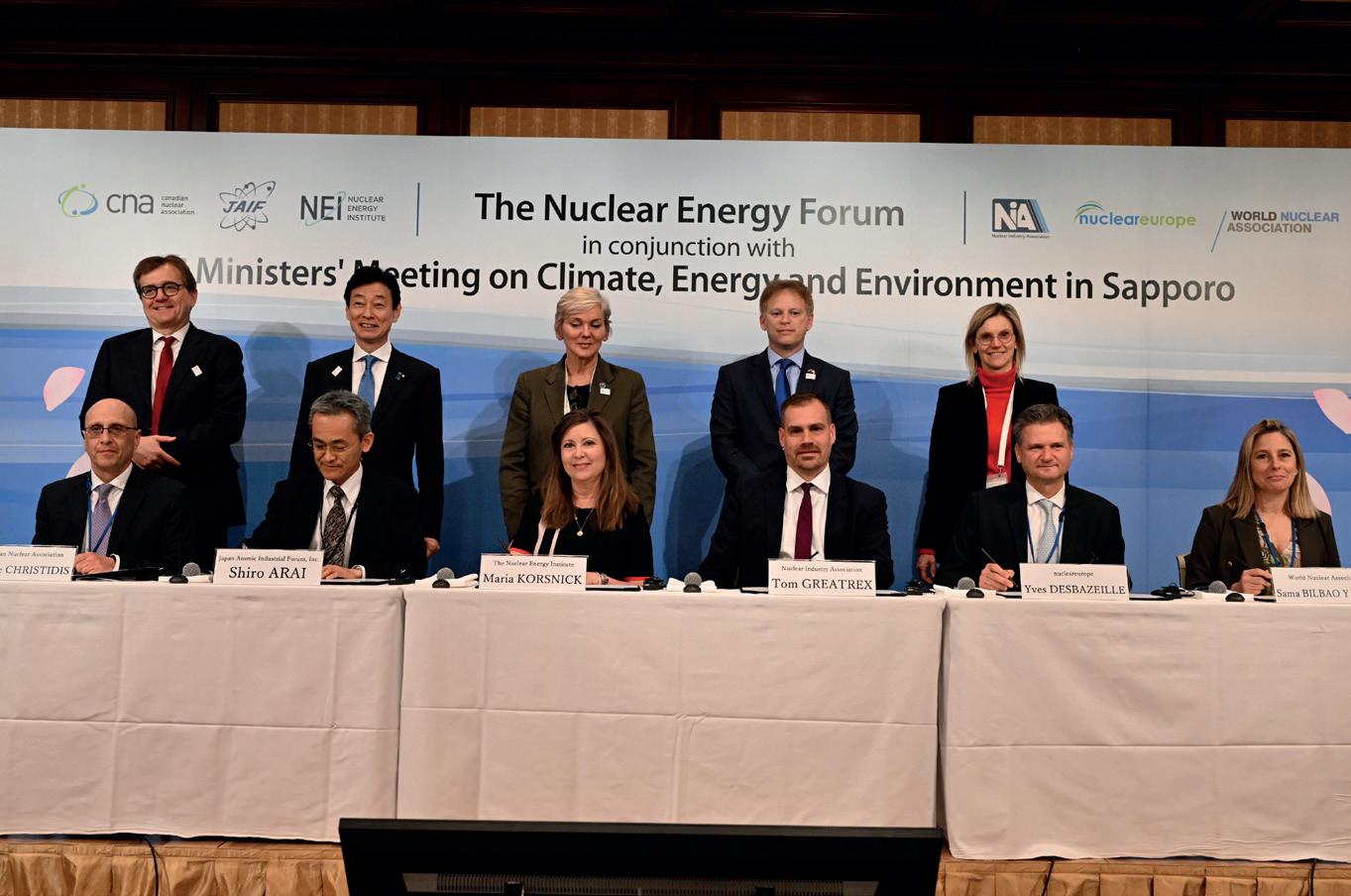
“ BY OFFERING THE TECHNOLOGY AND FUEL TO DEPLOY NUCLEAR POWER, RUSSIA’S APPROACH DELIBERATELY CREATES A PATH OF DEPENDENCY ON RUSSIAN MONEY, CAPABILITY AND GOODWILL, WHICH THE KREMLIN CAN RUTHLESSLY EXPLOIT.”
The UK is on a mission to reach 24 GW of nuclear by 2050. Meeting that target is essential if we are to meet key climate targets and sure up energy security. Given where are now with 5.9 GW, it’s a tall order, but an achievable one if the right action is taken.
The fact that we even have a target at all is proof of a shift in political thinking around nuclear, which is a far cry from where we were only a few years ago. But change needs to happen across the board, from the bottom as well as the top, for a real shift to take place.
We are starting to see that change happen. For over fifteen years the NIA has been tracking attitudes towards nuclear and every year we learn something new. The polling, which is carried out by YouGov, of a sample of around 2,000 people, measures the national mood, so what do this years’ numbers tell us?

The appetite for Britain having a mix of energy sources to ensure a reliable electricity supply is greater than ever, with 81% of those polled agreeing that we need it. It’s the highest proportion since tracking began back in 2005. Those who disagree remains consistent at 9%. It is also encouraging to see support for building new stations increase, with half of people polled saying they back new build. The top motivator being that it will provide a new energy source (68%).
Favourability of the industry has also risen, now at 34%, which is on par with 2007 levels. Unfavorability has continued to decline since 2019, bringing it in line with the 17% we saw in 2010, the lowest since we started tracking. Job creation (59%) has surpassed reliability (57%) as the most commonly mentioned advantage of nuclear energy, while preventing climate change (43%) has risen to the third most mentioned advantage.
Nuclear’s role in bringing jobs and investment to local communities is one of the industry’s enormous benefits, and for the fourth year in a row it is the most popular energy source for those two issues. Nuclear is also seen as the most popular choice for keeping the lights on.
But there is still work to be done. The number of people who see nuclear as ‘low-carbon’ has fallen slightly, with safety and cost still the most commonly mentioned disadvantages. That is despite the science telling us that nuclear has the lowest lifecycle carbon of all technologies as well as having one of the best safety records of all energy sources. On cost, we know that more nuclear will mean less expensive fossil fuel and cheaper energy bills.
There remains too a gender split, with women significantly less likely to be favourable to nuclear compared to men. This is not unexpected, with
polls and surveys consistently finding a wide gender gap on nuclear going back decades. Attracting more women and girls into science and engineering fields would go a long way in changing those numbers.
When looking at the separate UK nations, the poll presented some interesting numbers, particularly in Scotland where 44% backed replacing the current stations, versus 28% who opposed. Admittedly, this was a very small sample, but a separate poll carried out by Opinium for Britain Remade, the pro-growth group, threw up some similar numbers. Over half (55%) said they would back new nuclear projects in the country if it meant helping them reach net zero targets, which of course it would. 29% were against.
Interestingly, among SNP voters, 44% believed nuclear power should be included in Scotland’s energy mix, with 39% opposing. This, from a party that has been very vocal in its opposition to nuclear.
It is often the case that the more people know about nuclear, the more likely they are to be positive of it, which is partly what is driving these shifts in perception. From the energy crisis pushing up gas prices to the War in Ukraine highlighting the need for greater energy security, nuclear is having its moment when both political support, at least from the two main UK parties, and public support is in tune.
The prospect of a new nuclear project coming to Wylfa on Anglesey in north Wales is never too far from the Welsh press, with the promise of new jobs and substantial investment two major drivers. In May the NIA’s Head of Communications, Iolo James, spoke to BBC Cymru Wales’s Newyddion programme to react to a Welsh Affairs Committee report into new nuclear in the country.
The report concluded that new nuclear projects could be a ‘game-changer’ for the north Wales economy, but action was needed to make projects happen. Iolo told the programme that Wylfa is one of the best places in the UK for new nuclear and that there was now real political momentum to make projects like Wylfa happen.
The NIA’s Director of Policy and External Affairs, Lincoln Hill, spoke to the Daily Telegraph on the partnership between the UK, Canada, Japan and France, which aims to squeeze Russia’s share of nuclear exports, particularly when it comes to nuclear fuel.
“The main challenge,” according to Lincoln Hill “is to get out of the asymmetric mindset we’ve been in. In the past, the West has seen this as a purely commercial, marketbased situation and the Russians approached it as a strategic priority, so our companies were undercut and struggled to compete.”
In April, Germany shut down their last remaining nuclear power stations, bringing to an end the country’s campaign to phase out atomic power. The NIA’s Chief Executive, told The Guardian that the phaseout would worsen carbon emissions and “for a country supposedly renowned for its logical and evidence-driven approach is environmentally damaging, economically illiterate and deeply irresponsible”.
He also told the paper: “At a time of heightened concern about energy security, Germany will be abandoning assets that can displace 34 billion cubic metres of gas a year.”
Reacting to a report from RePlanet on how the recycling and repurposing of nuclear waste as fuel for reactors could enable the generation of more than 2,000 years of zerocarbon electricity for the UK, Tom Greatrex said: “The sky’s the limit when it comes to producing low-carbon electricity from spent nuclear fuel. It offers an innovative way of producing abundant clean energy to ensure energy security and hit our net-zero goals, alongside other reactor types and clean energy sources. The UK can and should be leading the deployment of these technologies, and companies like UK Atomics and Newcleo are already looking to develop their technologies in Britain.”
The Sunday Times reported on the Bill Gates backed TerraPower, the company that’s looking to develop their AMR technology in the UK. They’re developing a Natrium reactor which the company says can flex its output to meet energy demand on the grid. The NIA’s Tom Greatrex told the paper that AMRs and “SMRs have a potentially pivotal role to play”, but he urged GBN to “work at pace” to make them happen.
For full versions and more details on these and other stories visit www.world-nuclear-news.org
Funding of up to $275m to advance the deployment of a NuScale Power Corporation VOYGR small modular reactor (SMR) plant in Romania was announced at the G7 leaders’ summit.
NuScale and RoPower Nuclear are conducting a FEED phase 1 study to analyse the preferred site of the first VOYGR-6 SMR power plant, which is a former coal plant in Doicesti. The new funding will support the phase 2 study which also initiates the process of securing authorisations and licenses for the project.
Westinghouse has launched the AP300 small modular reactor, a scaled-down version of its AP1000 reactor, with a goal for the first one to deliver power to the grid within a decade.
Based on AP1000 technology, the SMR is an ultra-compact, modular constructed unit leveraging the innovation and operational knowledge of the AP1000 fleet and will use identical technology including “major equipment, structural components, passive safety, proven fuel and I&C systems”.
The AP300 SMR will sit between the AP1000 and the eVinci microreactor, a range of products which, the company said meant Westinghouse was providing “the technology to create a sustainable future and enhance energy security around the globe and eventually in outer space”.
Up to 20 Holtec SMR-160 plants will be built in Ukraine under a cooperation agreement signed between Holtec International and Ukrainian national nuclear operator Energoatom.
The cooperation agreement envisions implementation of the first SMR-160 Pilot Project with the goal to reach minimum controlled reactor power and connection to the grid by March 2029,
In 2018, a memorandum of understanding was signed between Holtec and Energoatom envisaging the adoption by Ukraine of Holtec’s SMR technology with the country becoming a manufacturing hub for SMR-160 reactor components.
The Ukrainian manufacturing hub is to mirror the capabilities of Holtec’s Advanced Manufacturing Plant in Camden, and will be one of four manufacturing plants Holtec plans to
build at distributed sites around the world by the mid-2020s.
Sweden demonstrates a solid commitment to ensuring the safe implementation of nuclear radioactive waste and used fuel management activities, including its efforts towards establishing a deep geological facility, an IAEA team of experts has concluded.
The IAEA sent an Integrated Review Service for Radioactive Waste and Spent Fuel Management, Decommissioning and Remediation (Artemis) mission to Sweden at the request of the country’s government to support it in meeting European Union obligations under the Council Directive on radioactive waste and used fuel management.
Artemis missions provide independent expert opinion and advice, drawn from an international team. The team recognised the way in which Sweden has developed and implemented the KBS-3 concept for used fuel disposal as a good practice. The KBS-3 system consists of a central facility for interim storage and encapsulation of used nuclear fuel, a transport system for the transportation of canisters with encapsulated used nuclear fuel and a final repository facility.

Thirty miles east of Edinburgh, on a plot of land measuring roughly one-tenth of square mile, sits a bastion of Scottish clean energy production. It’s 35 years since Torness was switched on for the very first time and since then it has produced enough electricity to meet the needs of every home in Scotland for 29 years. But in less than five years’ time Scotland will have no large scale firm clean power at all.
At its height Scotland had 3 GW of nuclear capacity. It was a blink and you miss it moment, but for a brief period, Torness, Hunterston A, Hunterston B, Chapelcross and Dounreay nuclear power stations were all online at the same time. From a tiny land footprint, these stations have provided the backbone of power in Scotland, saving well over 400 million tonnes of carbon emissions in the process. They are Scotland’s most important climate heroes. Nothing else comes even close.
Rather than aping Germany’s environmentally illiterate stance in celebrating the closure of nuclear plants, while burning record amounts of the dirtiest form of coal to make up the gap, Scotland as its political establishment is usually keen to do should look to Sweden and Finland, both of which have fully decarbonised power grids using a combination of nuclear and renewables. The arc of sustainability includes countries that can rely on enormous hydro power capacity, but Scotland has incredible wind power potential, a real clean energy trump card.
Building more wind turbines, though, will not help Scotland on still, windless days. Take today for example, nuclear is generating half of Scotland’s power, and all from one station, Torness, which takes up just 0.11 square miles of land. The rest is coming from a mix of wind ( on a comparatively low output day), solar and hydro and a small amount of gas. It’s nuclear and renewables working together to give Scotland the cleanest power in the UK.
The big difference between Scotland and its Nordic friends across the North Sea though, is whilst the Scottish government can’t get beyond a stance stuck
in the past and ignorant of climate, both Sweden and Finland are going in the opposite direction. Earlier this year, Sweden made changes to its law to enable more nuclear stations to be built. Its Deputy Prime Minister said the country needed “fossil-free, cheap electricity” and that “nuclear power is a necessary basis in the energy mix.”

Finland too just connected Europe’s most powerful nuclear power plant to the grid with Finnish customers seeing an immediate read through to much reduced electricity prices. The Finnish Green Party is backing nuclear too, because after all nuclear is just as green as wind or solar. Other countries are also planning to ramp up nuclear, including France, the Netherlands, Ukraine, the US, Canada and South Korea. Even Japan is trying to restart its reactors.
Nuclear naysayers will play the “too slow and too expensive” card but if we built reactors in fleets with a proper strategic programme, we can build them quickly. France built reactors in five years each when they had 30 under construction at once. And existing nuclear is just as cheap as renewables, and, with the right financing models, new nuclear can get there as well too.
There are also signs that the Scottish government policy is increasingly at odds with what the people want. A poll released last week by the pro-growth group, Britain Remade showed there is support with 55 per cent of those polled saying they would support new nuclear in the country if it helped it reach net zero targets, which of course it would. 29 per cent were against. The NIA’s own polling yielded similar results.
Has the time come then for Scotland to change course? It’s not too late: like all countries, it will need clean, reliable, power way past 2050. It was Robert Burns who penned the line, “now’s the day and now’s the hour” perhaps now, at a point of impending renewal of the Scottish political scene, it is time for science and the environment to be put ahead of simplistic sloganising in finding the right climate future.
With energy security, the rising costs of energy and Net Zero at the forefront of all our minds, we must find ways of getting new forms of clean energy onto our system. All ideas should be embraced and supported if we are to achieve the scale of the task. In this article, I aim to show a different approach to deploying nuclear at pace, changing perspectives on how nuclear can be developed and the current opportunity, if we embrace the change.
UK Atomics has developed a new model scalable nuclear that delivers the lowest cost of energy at £20/MWh without the need for Government funds and based on a UK-Danish energy partnership.








Today’s market is not tomorrow’s. We know and understand this. The question we must address is: what does that future market really look like? What if we don’t even realise a change is needed. I remember a friend once saying a phone is for talking, why would I want to email or watch films on it? We do not always recognise the need for change, a new shift, a new market, or a new paradigm.
In nuclear, we have a major challenge; how do we ensure energy security, achieve Net Zero and decarbonise the hardest to abate industries? We need a paradigm shift in developing nuclear technology if we are to succeed. We believe that UK Atomics has an offering that can rise to this challenge.
Paradigm shifts are nothing new and if we reflect on the past we can see this. IBM and Apple faced changes to the Graphical User Interface (GUI) interface and battled with personal computers in a market where a computer was the size of a house and only for large corporations. Henry Ford looked at cars, “you can buy any colour as long as it’s black” and it replaced the horse and cart. The Wright brothers invented flying aeroplanes when flight was just imagination. The iPhone disrupted the market replacing Nokia and changing how we all operate today with smartphones.
UK Atomics is the low cost, scalable and nontaxpayer funded option open to the UK. UK Atomics is developing a technology that is disruptive in the way we deploy nuclear, not just manufacturing in a factory, but moving to volume production. Our technology provides, not just low cost electricity, but the lowest cost of energy; and not just fission, but a waste burner that can consume spent fuel.
At UK Atomics we are changing the way we develop and deploy nuclear to market. We are heavily focused on developing the technology finding the fastest routes to commercialisation not just of a reactor and nuclear power plant but the end-to-end process. Every test, every measurement, the instrument used, the components developed, integrated systems and technology is commercialised. Our agile product development approach builds on collaboration.
Plans are underway for the company to carry out a criticality test by 2025 and we consider the UK a perfect location for a host site. In a recent live-streamed tour of UK Atomics’ facility, our Founder and Chairman Thomas Jam-Pedersen and I outlined how the company has moved to this technology readiness so quickly and the approach being taken a product led approach.
UK Atomics is following a product-led approach that forces us to consider the minimum viable route to commercialisation at every stage. Developing products with enough features for development enables UK Atomics to gain the support of earlyadopters, clients, investors and validates our products and reactors much earlier in the product development cycle through a series of tests and rapid interactions to build databases of knowledge.
Our view is that to enable a new technology and follow a path that nobody else has taken, it is best to build the industry, work in collaborative partnerships, share knowledge, experience and ultimately, develop. Our components, systems, and even test equipment is used by academia such as Leeds University and Massachusetts Institute of Technology. We are developing underpinning validation with Liverpool University, working with laboratories around the world such as Argonne National Lab in the US, and even other reactor vendors. The advantage this provides is pace of technological development and a community of knowledge not limited by resource constraints, or geography. To develop a new industry, we need to develop the players in the industry, so collaboration is vital and this collaborative approach builds the databases of knowledge faster than developing on our own.
We have been building industrial capability and capacity. These industrial collaborations have resulted in a portfolio of products that have already been commercialised, from Salts at one tonne per month now scaling to commercial plant production rates, to Molten Salt Loops for static and dynamic environments. World firsts with pumps, new instrumentation tested; control systems architecture validated and major components such as heat exchangers with key life testing.
UK Atomics is building on the long-established and well-trusted UK-Danish energy partnership. By extending this into nuclear energy we can capitalise on existing experienced regulators; existing nuclear sites; and, an existing environment open to technology development. UK Atomics’ technology can expedite benefits to market at pace. Targeting £20/ MWh, UK Atomics can help to ensure that the UK has security of supply with the potential for commercial plants to be ready by 2028. If we reach this goal, it will help to position the UK to be a world-leader in nuclear science as well as in molten salts.
The UK Atomics reactor resolves the disposition of the UK stockpile, turning 140 tonnes of liability into an asset, producing 30GWe for 50 years and generating a £780bn asset to the UK. Our approach enables industrial capabilities to mature alongside technology development.
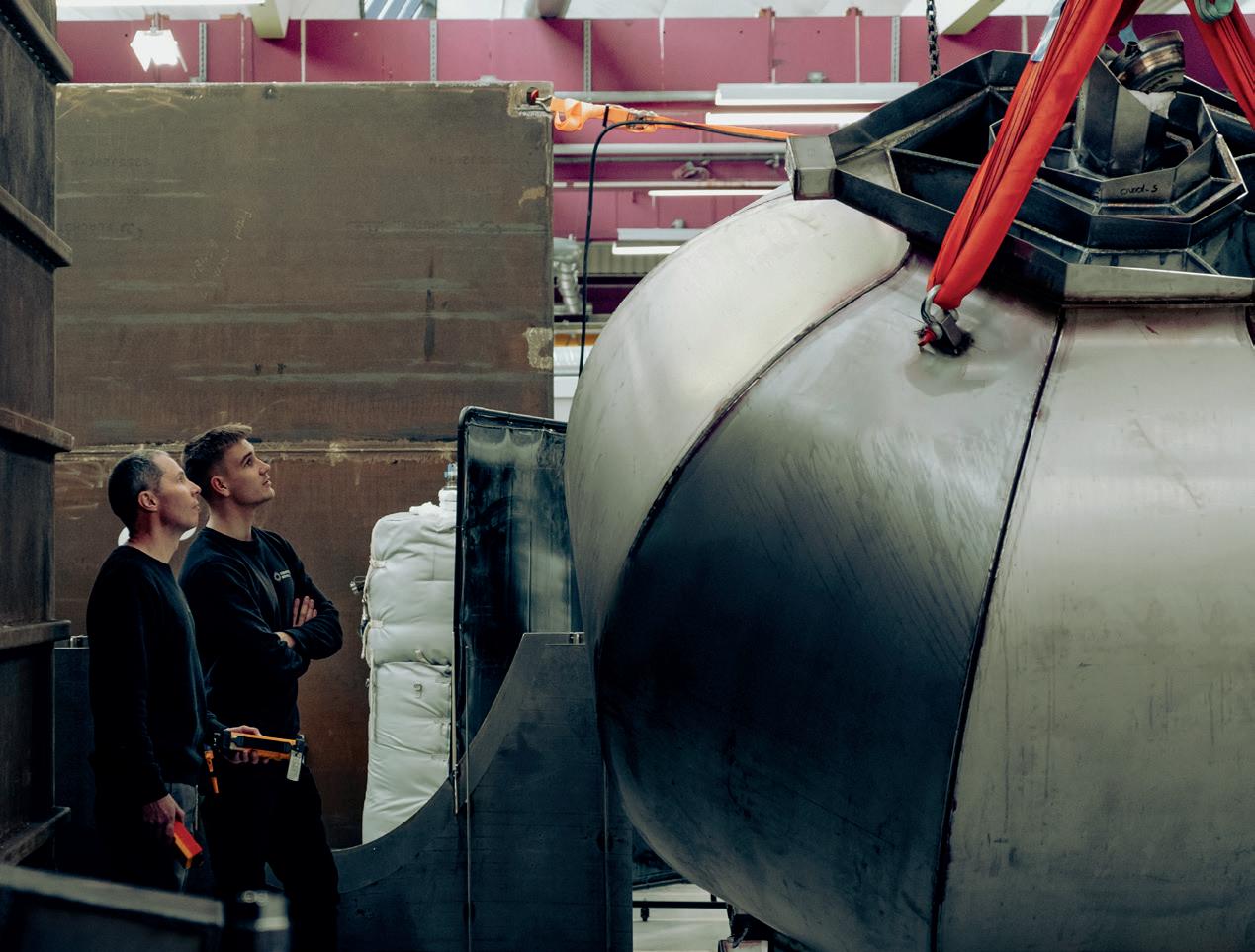

We can remove the need for large complex infrastructure and simplify deployment by removing the need for Balance of Plant to be classified as nuclear and therefore reducing the nuclear site licence footprint and enabling power generators to collaborate by using the heat produced for industry or grid. We can even re-use existing infrastructure for old power stations.
UK Atomics uses 40ft iso container units with case integers of 100 MW thermal meaning that we can manufacture one reactor per day

from the factory line. It is a deployment approach that scales using 25 units (reactors) per 1GWe power plant, that are not only factory made, but shipped direct to site and are ready to operate.


This means that nuclear power can move closer to volume production akin to the car industry resulting in the ability to deploy faster, and at pace. With £20/MWh and scalability, industry can not only decarbonise but re-onshore to the UK, providing new jobs and levelling up opportunities. It will potentially lead to companies investing in developing new technologies in the UK that might benefit from a very low cost of energy and helping British industry to end its reliance on fossil fuels.
If we are to support product-led development and reach commercialisation at pace. We must provide the necessary environment to support and we can learn plenty from other industries such as wind or even our own industry. Learning opportunities on contract mechanisms to enable the market, building on Contract for Difference Auction rounds. Learning from existing regulatory processes within the ONR to support regulation alongside technology development through adoption of the ONR’s Innovation Process and applying it to Advanced Nuclear Technologies. Processes for planning such as Development Consent Order can learn from the fast track process being progressed or the site based criteria approach for site selection for the Wind industry. We should use processes and learning that already exists to fast track development.
While we seek interested sites for hosting our 30 day criticality test, we will quickly move forward to a 100 MW thermal single unit demonstrator thereby providing the commercial readiness by 2028. The ANT Market Model paper, published by NNL in April, shows that market demand exists and that advanced nuclear technologies can address a global electricity demand to the value of £2.9 tn. By setting the pace for technological maturity at pace, we can access this market, begin to address it, and take advantage with the UK as a first-mover.

Creating the conditions for a paradigm shift is one thing, making it happen is an entirely different proposition. UK Atomics is setting out to make this paradigm achievable and aims to set a new standard for nuclear deployment. This new model does not just represent a low cost, scalable and non-taxpayer funded option but at £20/MWh it will be the lowest cost of energy.
Our technology won’t also just be built in a factory environment, we plan to produce one reactor per day. If you are going to change, then take a lead and aim high. We need to change perceptions of what is acceptable, what can be achieved and how you go about it. Most importantly, we must show everyone that we are not just talking about it but are living our mission. Collaboration is key, a UK Danish partnership can achieve this. Like others globally, join us in collaborating. Be part of the journey with us and live it.



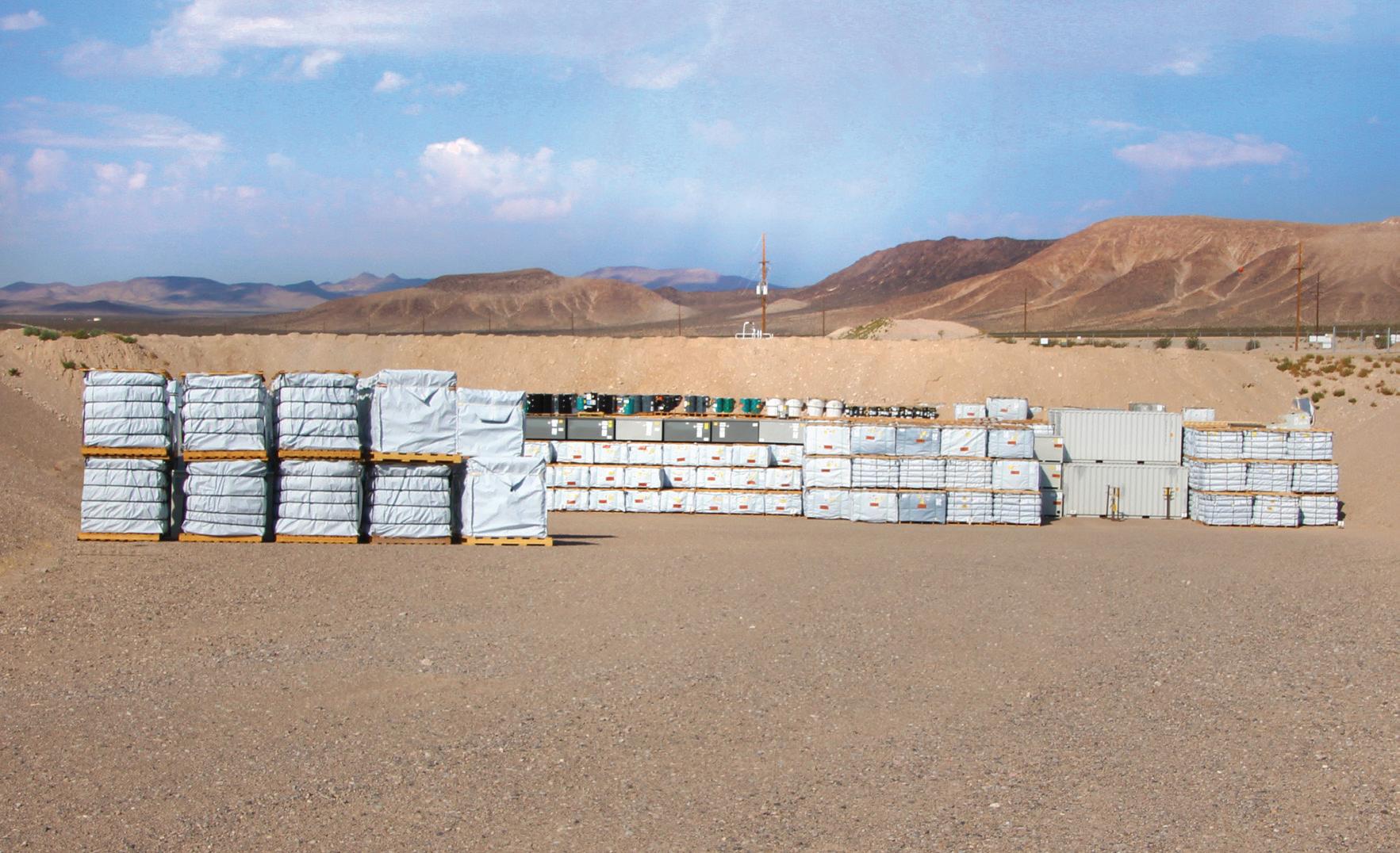









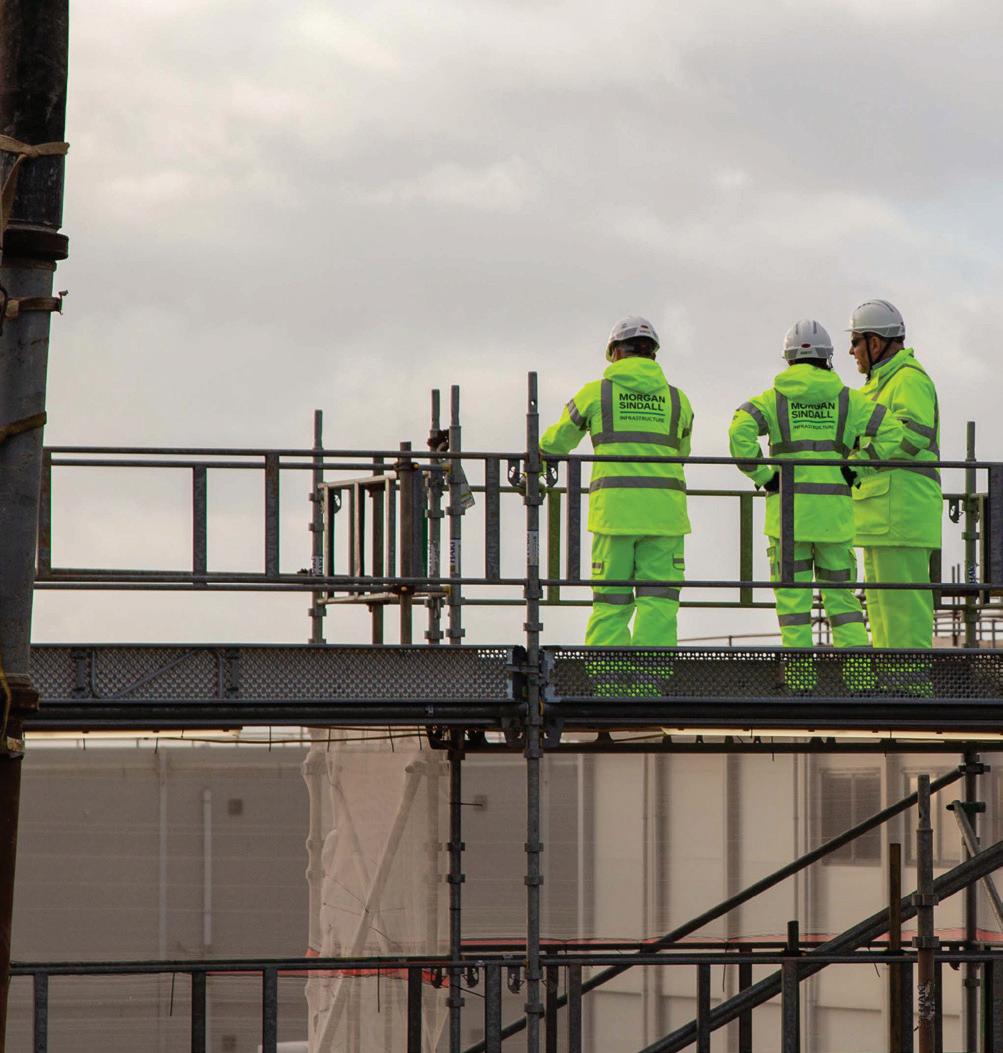
Describing the value to society of a new asset or piece of infrastructure is no easy feat, especially if you try to articulate the return on that investment for those in the direct vicinity.
We know there is a legal requirement for social value assessments to be made on public services but what more can be done to measure the impact made and the legacy generated?
With the life span of an asset anywhere between 10 and 120 years, we can create an extraordinary amount of social value but only if we embed our initiatives upfront when we also have a huge amount of influence.
We deliver social, economic, and environmental value to society, not only through our technical and professional solutions, but by investing in local communities and maximising our social impact to ensure we leave a lasting legacy.
which they live with. Communities and people need our support to ensure their futures and their environments are sustainable.
The National Themes Outcomes and Measures (TOMs) Framework set out and curated by the Social Value Portal is a well-established resource and HM Treasury’s Green Book guidance on Wellbeing evaluation, is robust and comprehensive. Yet there are traps to navigate.
It’s important to understand the impact of our social, economic and environmental initiatives but there’s also a risk we’ll dive too deep into the detail and overlook other, less straightforward but potentially transformational, opportunities.
Equally, if we’re putting too much emphasis on the data, we risk simplifying complex human interactions so we can put a pound sign next to them.
We also need to consider social value in totality, rather than in isolation. The three main phases of a project or asset life cycle design, delivery, and operation and maintenance are interdependent. Likewise, social value is related at a system level to the economy and the environment.
Costain uses digital technology as a key enabler of social value for our clients. We use Geographical Information Systems (GIS), to focus our activities on unique stakeholder groups, and to develop a deep understanding of local community needs.

It fuels social mobility and allows people to feel valued as part of their community. It helps people feel connected to the environment in
Digital stakeholder platforms are key to capturing and visualising data relating to stakeholders’ authentic voices. Digital platforms are also essential for capturing social value inputs, outputs, and outcomes across the lifecycle of an asset and to model the impacts at a systems level. Data can then be used to improve impact, monitor outcomes, and communicate stories of change.
At Costain, making a difference to communities and people is at the heart of everything we do. We recognise the role personal wellbeing has in better life actions, improved mental health and social relationships, higher productivity and improved skills and educational outcomes.
Step 1 Who could benefit from the programme?
Understand the stage of the project, what benefits have been identified in the business case, how do these benefits align with the strategic drivers for the project, identify any gaps, and establish scope.
Step 2 Local stakeholder research
Build on insights from digital research and carry out further engagement with local stakeholders, both digitally and face to face. The goal is to capture the authentic voice of stakeholders and use digital systems to visualise that voice in both quantitative and qualitative terms.
Step 3 Develop outcomes and identify data
Co-design outcomes with the client, aligning them with strategic drivers and carry out a prioritisation exercise. For each outcome, define the input, output and impact metrics and data that will need to be captured.

Costain (as part of the Nexus Decommissioning Alliance) has been supporting Sellafield on its Decommissioning Delivery Partnership (DDP) since it commenced in 2016. The Framework is a long term 10-year contract enabling accelerated risk and hazard reduction, providing capacity and capability to deliver decommissioning tasks and projects.
The DDP social impact plan has been developed in alignment with Sellafield’s social impact objectives: Resilient Economies, Thriving Communities, Social Value Chains, Sustainable Incomes, Collective Impact, and Improve Performance, as well as SiX, Sellafield’s new social impact programme.
The themes were underpinned by several objectives created to ensure social value commitments were met and in turn each objective is measured twice a year through the TOMS framework.
With a focus across West Cumbria, monthly working group meetings ensure coordination and collaboration by all partners with the aim to prioritise the activities that are most effective. At the end 2023, a collective agreement will be achieved on which programmes and initiatives should be focused on, based on being the most beneficial to the community residents and young people.
Andrea Noblett, Sellafield Social Impact
Lead and Nexus Social Impact Representative, conducted a Gap Analysis to ensure that our understanding of how we can maximise support for communities in West Cumbria is aligned with the Sellafield SiX principles and the ‘Aligning the Social Pillar’ strategy. The insights gathered will pave the way for a strengthened Nexus social impact approach.
Step 4 Develop strategy and delivery plan
Identify appropriate local third sector partners and finalise the Key Performance Indicators (KPIs) for each outcome, aiming for a range from minimum compliance to aspirational targets. Input resources and budgets are defined and agreed.
Step 5 Implement and Deliver
Work with the client team to implement and deliver the strategy and plan including using our expertise in delivery methodologies, developing a Service Level Agreement (SLA) with key partners and planning to increase the capacity and capability of these partners beyond the project.
Step 6 Establishing impact
Capture the appropriate date to evaluate impact. This data is obtained directly from the stakeholders and beneficiaries of the activities and supported by client and market information. We work with the Client to select transparent and auditable monetisation options that capture the impact on wellbeing, and we support the benchmarking of the impact.
Step 7 Evaluate and improve
The final step in our process is to evaluate, learn lessons and improve for the next project. We work with stakeholders and beneficiaries to verify the authenticity of the outcomes and their impact. We provide an audit function for clients or for their supply chain to ensure the veracity of the data and reporting process. We evaluate the efficiency of delivery through our impact focus and where appropriate we use our accredited Social Return On Investment (SROI) methodology to evaluate factors such as attribution and duration of impact and to calculate an SROI ratio. Finally, we celebrate success by communicating impact internally and externally, share best practice, and where appropriate publish research.
By using a structured methodology and engaging all stakeholders, social value becomes part of the project or programme and not a side distraction. It actually enhances project outcomes and ensures that considerations are made at all stages to the wider economic, social and environmental impact.
If you’d like to speak to one of our experts to understand how you can maximise the social value on your project, please contact jeremy.galpin@costain.coms.
Jacobs was selected to design and engineer remotely-operated tools for ITER, the world’s largest fusion power project.

A four-year framework with a possible two-year extension, the contract covers work on up to 25 diagnostic ports and systems that are critical for operating and sustaining the ITER experimental machine now being built in Provence, France.
The project will capitalize on extensive remotehandling experience and knowledge of the diagnostics and port cell areas gained from previous work.
“Our support of the maintenance of these diagnostics systems not only delivers on Jacobs’ commitment to climate response but also our purpose of creating a more connected, sustainable world,” said Jacobs Energy, Security and Technology Senior Vice President Karen Wiemelt. “Through our team in Aix-en-Provence, combined with the full strength of Jacobs’ global capability, we will work with ITER to channel our technology-enabled knowledge and experience toward benefitting people and the planet.”
ITER, which is supported by more than 30 nations, aims to create the conditions for a self-sustaining fusion reaction, which is a crucial steppingstone toward developing fusion power stations and creating a new source of emission-free, almost unlimited energy for the world.
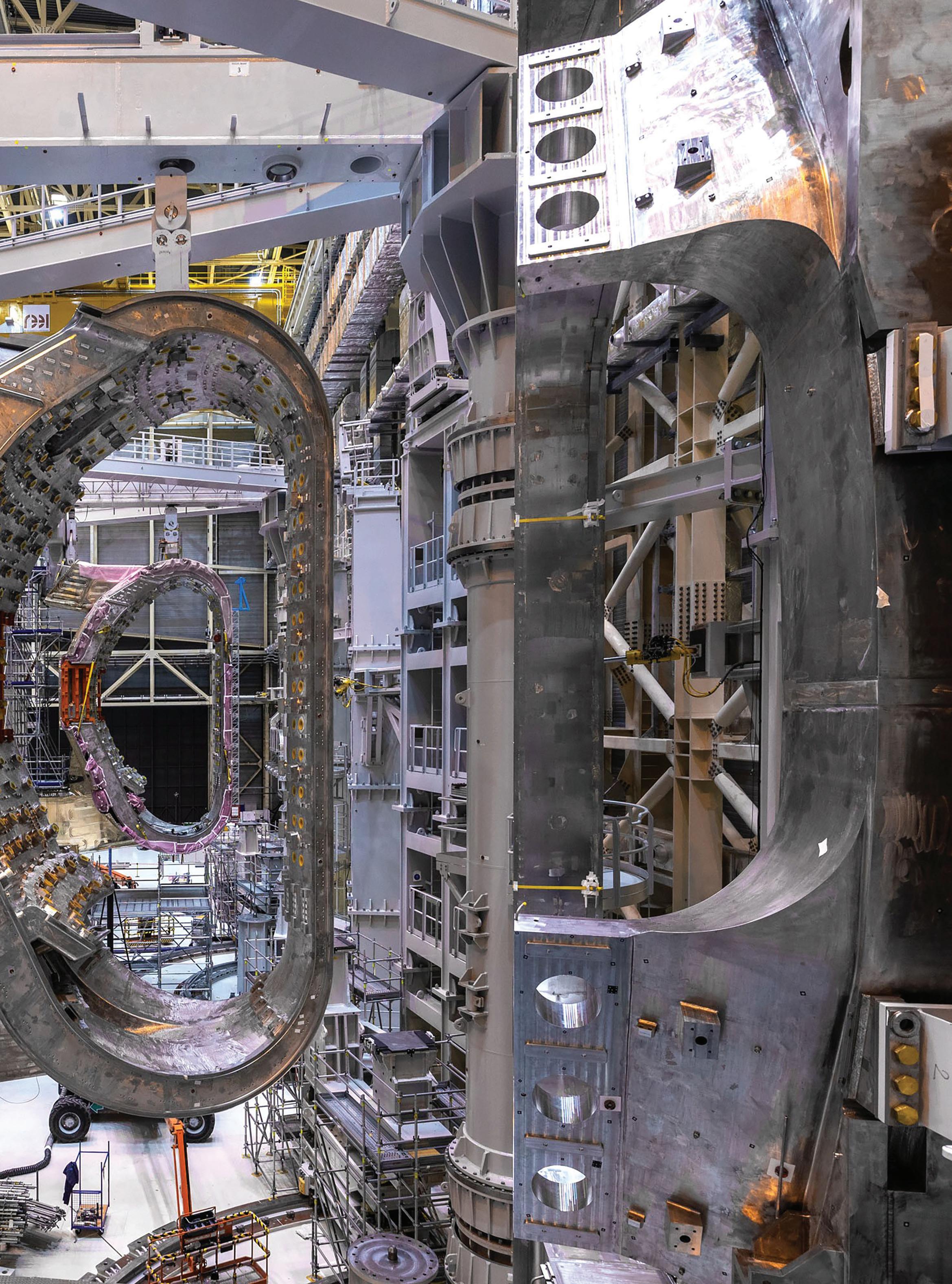
Cwmni Egino, the company behind plans to develop the former nuclear power station in Trawsfynydd, has completed its first phase of development work confirming the viability of deploying Small Modular Reactors (SMRs) at the site.
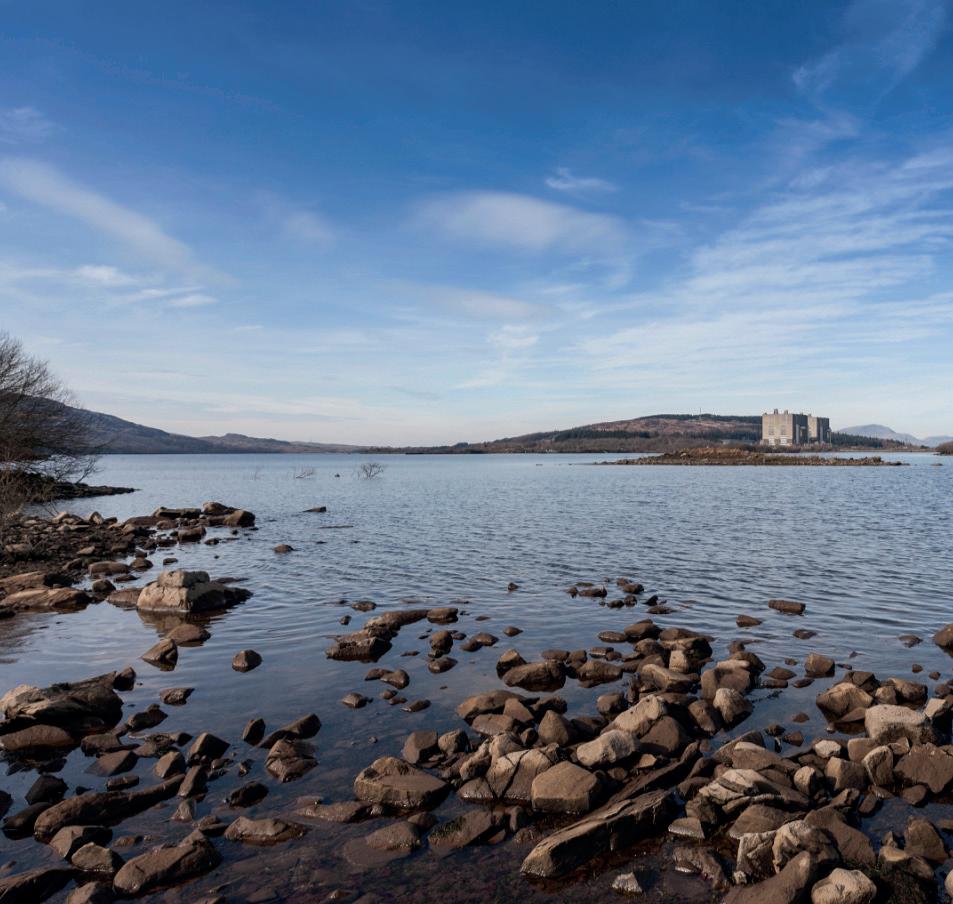
Development work undertaken by Cwmni Egino to date has established that land owned by the Nuclear Decommissioning Authority (NDA) could be suitable for a range of SMR technologies with the potential to generate up to 1GW of electricity.
Building on the work of the Snowdonia Enterprise Zone which identified the potential for SMR deployment, Cwmni Egino was set up by Welsh Government to promote economic and social regeneration by driving future development at Trawsfynydd.
It is estimated that SMRs at Trawsfynydd could create over 400 long-term jobs in the local area and over £600 million GVA for North West Wales and £1.3 billion GVA for the whole of Wales during over an operational life of 60 years. It would also create thousands of additional jobs during the construction stage, as well as through the Welsh and UK supply chains.
As the UK’s first site-specific development company for SMRs, Cwmni Egino has set its sights on being the first SMR project approved by the UK Government with construction starting before the end of the decade.
Alan Raymant, Cwmni Egino Chief Executive said: “In addition to meeting our energy needs and net zero targets, deploying SMRs at Trawsfynydd offers a huge inward investment opportunity for Wales. This is aligned with key policies and priorities of both the UK and Welsh Governments.
“We believe that Trawsfynydd presents the first, most credible opportunity to kick start a long-term programme of SMR projects in the UK, and catalyse significant economic growth locally, regionally and nationally. Cwmni Egino provides a development vehicle to drive this forward.
“Our plans are more advanced than other sites suited to small scale nuclear, and the work we’ve done over the past 12 months gives us added confidence that we can successfully deliver a project at Traws. We have already put in place a 5 year development programme which means our project can be ready for approval by the latter part of this decade in line with the UK Government’s energy security ambitions.”
The company is yet to select a technology partner for the project, and wants to work with Great British Nuclear (GBN), the recently formed UK Government body tasked with leading the UK SMR technology competition.
Alan added: “We’ve already been in discussions with a number of technology providers and there is
significant interest in deploying SMR at Trawsfynydd. We will work closely with GBN over the coming months to confirm the technology solution that best suits Trawsfynydd within the overall selection process for the UK.

“The other key area of focus for us now is to secure Government commitment to the next phase of the project. In particular, we need confirmation that Trawsfynydd is one of the projects GBN wants to be developed. This will give us the certainty that we need to unlock this opportunity and access additional development funding.”

Welsh Government Economy Minister Vaughan Gething said: “It’s great news Cwmni Egino has completed the first phase of its work at Trawsfynydd and that genuine progress is being made towards realising the company’s ambition to begin deploying small modular reactors on site by the end the decade.
“We established Cwmni Egino in 2021 so it could lay the groundwork to achieving significant socioeconomic benefits for North West Wales and to ensure it achieves this, it’s vitally important Great British Nuclear now engages meaningfully with Cwmni Egino so Trawsfynydd is formally selected as the first SMR site in the UK.”

For more information on Cwmni Egino contact info@cwmniegino.wales.
Based in the UK, France, and Italy with already more than 200 employees, newcleo secured €400 million in private funding and has an up-to €1 billion fundraise underway.

We are the new, innovative player in nuclear.


Grace McCrickard from JF Nuclear is the 2023 NSAN Apprentice of the Year and Advanced Apprentice of the Year. Having been brought up in the nuclear heartland of Cumbria, Grace started her career at 16 with a traineeship, and since then she’s gone from strength to strength, following her dream of becoming a Senior Electrical Technician. The NIA’s Leia Mouchous sat down with her to discuss her career so far and hopes for the future.
Huge congratulations on winning the awards but first of all, how did you start your career in nuclear?
“I left school at 16, and I went straight into the nuclear industry. I did a traineeship in performing engineering operations which was 80% electrical engineering which included mechanical, welding and pipe fitting. Upon completion, I knew what I wanted to do and at 17 I gained an apprenticeship, which started at JF Nuclear, specialising in electrical engineering. I am a control panel engineer, building control panels which control robotics. I’m in the ROV industry, and I absolutely love it. I recently became a senior electrical technician, which is good and I’m happy that I’m moving forward.”
It’s great to see you’ve been working your way up since you were 16 what kind of work have you been involved in so far?
“What I do is I build control panels that operate our ROV’s, so things like mini and micro diggers, which are in charge of cleaning up nuclear waste. We get a digger, strip it down and turn it into a remote control and I build the controls for it and all the underwater umbilical cables as it goes in the nuclear ponds in Sellafield site. That digger scoops waste to put into bins, so it’s all part of the clean-up. I am also an Unmanned Aerial Vehicle Solution pilot, so I fly industrial drones for inspections as well as operating the underwater ROV for inspections too.”
How have you found being a woman in STEM? Are there many barriers?
“I do think so, yes. At the start of my apprenticeship when I was 17 I was a lot more shy, so it was really daunting being in a male dominated industry. When I started at the company I was the only girl in the field services and I’ve been here for six years now and I still am the only woman here. I personally prefer it, but there was a lot of struggles at the start. I am quite a small person and when I was 17 I was extra tiny and I think walking into the industry you do get a few funny looks, but obviously I’ve proved everyone wrong and it only gives you more motivation to work even harder.”
I agree, it can be daunting but I’m glad you used the challenge to motivate yourself and not let it deter you. What would you say is like your biggest career highlight so far?
“To be honest, the thing that I enjoy the most has been building the underwater umbilicals and
to operate it and see it working. I know a lot of companies send designs away and someone else builds it. I personally like the fact that we design it, build it and then operate it and send it away, which is great. You see your project from start to finish.”
Moving on to your awards, what was your initial reaction when you found out you’d been nominated? And can you talk us through what happened at the ceremony that night?
“My boss, Michael Rogers, nominated me for the awards, which was amazing because my company has never done that before. I was the first person to be nominated, which was amazing, and I was taken back by it. I knew it was a big deal, but the more I got into it with the interviews the more I realised how much of a great opportunity it was.
“When I won the Advanced Apprentice of the Year my boss and I got on stage, and it was nice to share that moment with him because he’s been there since day one. He was the one that reached out to me about the job as I didn’t know about JF nuclear. We’ve got a good friendship, so it was nice to go on stage with him.
“And then I won the main award too, the Nuclear Apprentice of the Year, and that was the best feeling I’ve ever felt. The whole room stood up, it was absolutely amazing. It was overwhelming to be honest. I haven’t stopped smiling since!”
Has anything changed since winning the awards; any opportunities or career ambitions?
“Along with the City and Guilds CEO Kirsty Donnelly I attended an event at the Goldsmiths Hall to do a panel talk about my career. There were members of the House of Lords there who were getting the fellowship, which was amazing, and it was my first ever panel talk. I have a podcast set up with City and Guilds coming up soon too. I’m also giving a speech in Parliament for Nuclear Week in September, which I’m really looking forward to. There has been a lot of opportunities that have come out of this which I’m really excited for!”
It’s great to see your hard work paying off and you are seen as an inspiration to others who want to be in a similar position to yourself. What advice would you give those starting their career in STEM?
“My advice would be to make the most out of every opportunity you’re given and say yes to every opportunity too. You can definitely turn one opportunity into several more.”






Communication devices and software to keep your team connected, safe and efficient regardless of their location.

Let’s work together.

In mid-April, Germany shut down the second, sixth and eighth most productive nuclear reactors in world history. In so doing, the German government has persisted in a senseless act of folly, against all the science and available evidence.
They have chosen, deliberately, to go backward in the struggle to save the planet. They have chosen to burn coal rather than to split atoms. They have chosen to sacrifice billions of euros of clean energy investment and decades of expertise on the altar of crude ideology. Simply put, the German nuclear phase-out is the single worst decision Europe has taken in the fight against climate change, and one for which we all are paying the price.
The decision itself has no basis in science. Ostensibly, the accident at Fukushima drove the Merkel Government to revive the nuclear phaseout. The most important thing to know here is that Japan, where Fukushima happened, is trying hard to restart its 30GW nuclear fleet, even as Germany finishes shuttering a fleet of 20GW.
Japan has recognised that they can and should fix the foreseeable failures in plant resilience (waterproof back-up generators, build higher seawalls) and regulatory oversight that led to an entirely avoidable accident, minimise seismic risks, and continue safe nuclear operations. Germany, of course, had neither the shortcomings in plant resilience, nor the regulatory failures, nor the seismic risks that Japan had. They had no case for their decision.
The cost in carbon of that decision is catastrophic. To put some numbers on it, Germany had 20,490 MW of nuclear power in 2010. Those reactors could all have gone for 80 years, to the early 2050s at least, and the youngest ones
years beyond that. A well-run fleet that size can save 150 million tonnes of CO2 every year versus coal. Germany intends to burn coal until 2038, so we are talking about well over 1 billion tonnes more CO2 over that period.
Yes, Germany built out renewables massively, but that on its own is never enough. Without nuclear baseload, Germany burns coal, and lots of it. On a windy day yesterday, with 26GW of wind on the bars, they were still burning 16GW of coal for power. France, with its large nuclear fleet, and Sweden with its strong mix of nuclear, hydro and wind, were burning no coal at all. In fact, Germany’s own climate plans mean that they will burn more coal than anybody in Europe, much of it lignite, the dirtiest most polluting kind.
Coal, of course, does double the damage: carbon and air pollution. A Columbia University study from 2019 found that:
‘Germany could have prevented up to 4600 deaths and 300 MtCO2 cumulative emissions between 2011 and 2017. And if the country proceeds to total nuclear phaseout by 2022, it could lose the chance to prevent an additional 16,000 deaths and 1100 MtCO2 cumulative emissions.’
Back then, the Columbia authors wrote that ‘Germany can still prevent 16,000 deaths and 1100 MtCO2 emissions by 2035 by reducing coal instead of eliminating nuclear as planned’. They intend to forfeit that chance this weekend.
The shutdown wounds and galls us doubly in the nuclear industry because the German plants were run magnificently by their operators. They attained and sustained output levels beyond anything we have done in the UK, saving hundreds of millions of tonnes, probably billions of tonnes,
of CO2 in the process. Indeed, the alltime list of top 10 nuclear reactors by output features six German reactors. Three were shut a year ago. Three will shut this weekend. German nuclear workers set standards of professionalism and excellence that have now been spurned and discarded by German politicians.
Those politicians replaced that professionalism with the most tragic geopolitical naivete. Perhaps with cruel irony, Nord Stream 1 starting pumping gas from Russia to Germany in 2011, the same year the nuclear phase-out was announced. Also in 2011, Nord Stream AG start examining the Nord Stream 2 expansion to pump more gas from Russia. Germany’s nuclear fleet could displace the equivalent of 34 billion cubic metres of gas per year. Certainly, it would have nearly wiped out their need to burn gas for electricity. We know where that gas came from, we know what it funded, we know what that money did. We should never forget that whenever anyone calls for the end of clean, reliable, sovereign nuclear power generation.
The lesson of this tragic, awful decision is that facts and science matter: nuclear phase-outs do not work. The countries that try them burn more coal, import more gas, and emit more carbon than those that stick with nuclear. Those are the facts, clear and incontrovertible. Nuclear energy is clean and green: that is science too.
If we believe in the fight against climate change, and the need for energy security, we will do everything, everywhere, all at once. We will not pick and choose energy sources based on prejudice, but do our utmost for a sustainable future for our children, our grandchildren, and generations to come.


Hinkley Point C has announced 30,000 new training places between now and the power station’s completion, helping local people to join the project as its hits peak construction.
Trainees will be able to upgrade their skills and earning potential by joining the work to fit miles of pipes, cables, equipment, and control systems. The opportunities have been made possible by Hinkley Point C’s £24 million investment into education, skills, and employment, including at three new Centres for Excellence in welding, electrical and mechanical skills.
Courses will be available in in-demand skills such as electrical work, welding, steelwork, and pipe installation. The training centres will become part of Hinkley Point C’s legacy, available for local and national businesses to enrol their own employees, which will help to strengthen the region’s industrial capability.
The figure was released in Hinkley Point C’s 2023 Socio-Economic Impact Report, which shows that:
● Spending in South-West has topped £5.3 billion with 1,300 companies
● Investment in local infrastructure and community support has reached £139 million
● Grants to fund local projects hit £14.5 million
● 1,130 apprentices have been trained so far
Hinkley Point C’s contracts are also supporting and creating thousands of jobs across Britain. For example, more than £1.2 billion has been spent in the North-West of England with 130 companies. In North Wales, a new factory to make specialised pipework at Broughton has recently opened, creating 200 new skilled jobs.
As well as apprenticeships, the project has also expanded its T-level scheme for those at the very beginning of their careers and is offering a Supported Traineeship programme for those with learning difficulties.
Ansaldo Nucleare and Westinghouse Electric Company announced a milestone achievement in their work on the Generation IV lead-cooled fast reactor with completion of the first testing campaign at the Passive Heat Removal Facility recently built at the Ansaldo Nuclear plant in Wolverhampton.
The companies performed the work under a contract within Phase 2 of the Advanced Modular Reactor program partially funded by the UK Government’s Department for Business, Energy and Industrial Strategy, which was awarded to Westinghouse with Ansaldo Nucleare as the main supplier.
“With this milestone we have added another important element to the future of Generation IV reactors. Together with the UK subsidiary Ansaldo Nuclear Ltd, Ansaldo Nucleare remains at the forefront of Westinghouse Lead Fast Reactor development: a fruitful collaboration we can only be proud of.”
art experimental facilities to support Westinghouse’s lead-cooled fast reactor (LFR) technology, the Versatile Loop Facility and the Passive Heat Removal Facility. These test facilities are a key asset for collecting experimental data supporting accelerated development of LFR technology.
“Moving into the testing phase utilising these large-scale test facilities clearly demonstrates the maturity of the reactor development project that Westinghouse and Ansaldo Nucleare are advancing. Our project goes beyond design and modeling activities, and includes hands-on activities contributing to enhancing our practical knowledge of LFR technology.”
Mark Urso, interim Chief Technology Officer of WestinghouseRiccardo Casale,
Chief Executive Officer of Ansaldo NuclearAs part of this contract, Ansaldo Nucleare led the design, purchase, installation and commissioning of two state-of-the-
This achievement is part of the wider initiative launched by the cooperation agreement signed last October between Westinghouse and Ansaldo Nucleare for the joint development of Generation IV LFR technology globally, and with near- term emphasis in key European countries such as UK, Romania and Belgium.
ATS Industrial Automation announced a contract for their nuclear division with NuScale Power to build and test a prototype for the Module Assembly Equipment-Bolting (MAE-B) system, a critical part of the NuScale VOYGR™ SMR power plant.
The MAE-B system includes prototyping the automation technology to be used on the Reactor Flange and Containment Flange tools. Extensive testing will be performed on the system to provide confidence that the technology will operate as intended for the NuScale Power Module™.
The prototype, which will serve as a proof-ofconcept system, will be assembled and tested at an ATS facility in Wixom, Michigan.
ATS Industrial Automation delivers proven automated tooling solutions, concurrent engineering, and digital twin technology for nuclear refurbishment, decommissioning, and small modular reactors. The company specialises in solving the most complex nuclear automation challenges with innovation, ingenuity, and experience.
United Kingdom Atomic Energy Authority (UKAEA) has launched a new tritium training course taking place on 27 June 2023 as part of its commitment to upskill the fusion industry. The course is being launched for the wider fusion industry following a successful pilot course in April, which was attended by a team from First Light Fusion.
Tritium is a likely fuel of future fusion power plants, which will combine the hydrogen isotopes of deuterium and tritium to generate electricity.
Managing, storing and supplying tritium fuel is vitally important for the commercialisation of fusion energy. UKAEA has been safely handling, processing and storing tritium for more than 40 years as part of its research into fusion energy. The course will cover tritium’s chemical properties, behaviours and safety factors, before delving into tritium fuel cycle stages. It will also include the processes and equipment required within a tritium plant.
Turnbull & Scott is continually committed to investing in innovative products and in its dedicated workforce so that it can help customers solve and deliver the solution to their comfort or process heating, drying, cooling, chilling, and energy saving challenges. In doing so, it is increasingly passionate about helping companies work toward a NetZero future.
This award comes as a great birthday present for the company as it celebrates its 90th Anniversary this year.
“We are delighted to be receiving this award in 2023, the year we celebrate our 90th birthday. We have been quietly helping our customers to reduce their heat energy consumption for much of that time and to receive the Sustainable Development award is a huge honour, particularly in 2023 with so many companies doing so much wonderfully innovative engineering to solve the climate change challenge.”
Peter Murphy, Managing DirectorWinning the award rounded off a great week for Turnbull & Scott after exhibiting at the 2023 AllEnergy event in Glasgow. It provided the opportunity to connect with people and discuss creative ways in which the company can help its customers with their energy saving challenges.
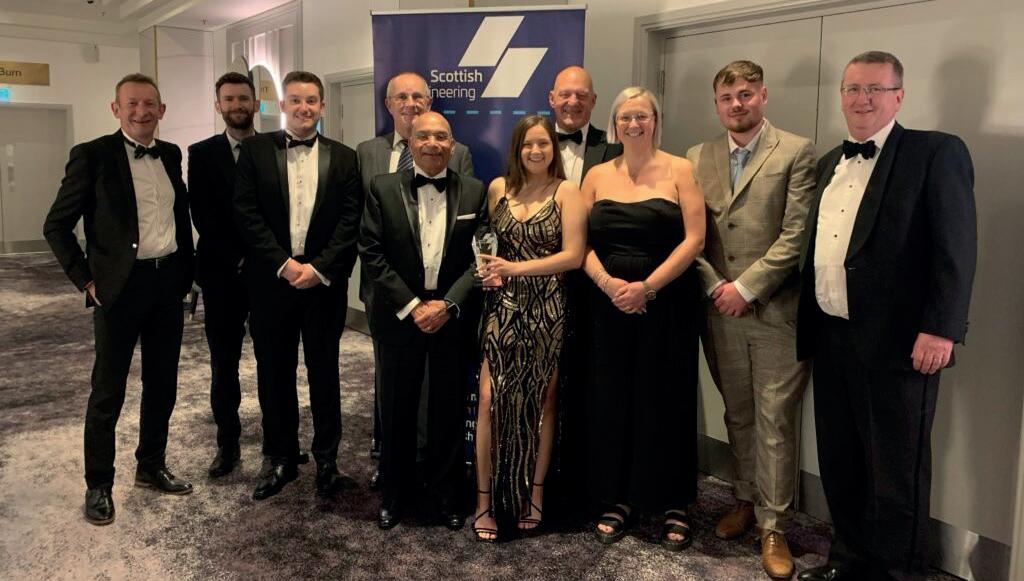
“UKAEA is committed to sharing our knowledge to drive forward tritium research across the scientific and engineering community. Fusion energy has the potential to be a safe, low carbon and sustainable part of the world’s future energy supply.”
Hayley Taylor, Tritium Training, Development and Recruitment Manager for UKAEA
UKAEA was pleased to recently host members of the First Light Fusion team for the successful pilot tritium training course.

“The training that UKAEA has provided has been really impressive and our team gained a great deal from the tritium course. The content matched what we needed and the delivery was engaging and focused. We’re looking forward to continuing this part of our broader relationship going forward.”
Ryan Ramsey, Chief Operating Officer of First Light FusionCourse attendees can speak with and learn from UKAEA tritium experts and will experience a tour of UKAEA’s tritium processing plant providing a unique opportunity to see the real-world application of what they have just learned in the training room.
The one day, classroom-based course is applicable to industry, academia, start-ups, graduates, new starters, scientists, engineers and operators with a range of tritium knowledge. Organisations can also contact UKAEA to request bespoke sessions tailored to their areas of interest.
For more information about future course dates this Autumn and to sign up for the next course on Tuesday 27 June 2023, at UKAEA’s Culham Campus, please contact info@h3at.ukaea.uk.
arc-cleantech.com


ARC is a clean energy technology company developing the ARC-100, an advanced small modular reactor offering inherently safe, reliable, and economical carbon free power.
The ARC-100’s simple, modular design provides 100 megawatts of electricity and industrial heat that will be cost competitive with fossil fuels.
astralneutronics.com
Astral Systems is a developer and manufacturer of the first multi-state fusion device, enabling unparalleled performance and lifetime in high-energy proton and neutron production. Simply put, there are no high energy particle generators available that are as compact, inexpensive, and long lived as ours.

Brevia is a public relations and public affairs agency delivering political and communications support to businesses and charities across the UK, and in Brussels and Washington DC.
It provides clients with an understanding for political environments, formulate strategies and effectively engage with stakeholders.
ES
es-steel.co.uk
With over 22 years’ experience, our teams guarantee the safety and the effective, efficient installation of the finished product.
Working across the Petrochemical, Process, Pharmaceutical and Nuclear Industries, we have a proven track record of accuracy and efficiency.
extract-technology.com
DEC Group Extract Technology manufactures design-build and build-to-print nuclear containment and radiopharmaceutical gloveboxes and metallic hot cells. Serving government agencies, research sites, prime contractors, and radiopharmaceutical clients.
GRAHAM
graham.co.uk
We are a privately owned company with an impressive history built on integrity and responsibility, providing technical engineering, design and construction expertise. Specialising in bespoke building, civil engineering, interior fit-out, facilities management and investments.
M5TEC
m5tec.com
M5tec is a multidiscipline engineered solutions provider and consultancy. Our team consists of experienced and enthusiastic engineers dedicated to supplying high-assurance industries with new and innovative solutions to engineering challenges and committed to delivering engineering excellence on every project.
We supply high quality filtration solutions to global nuclear industries. Working across the field, designing and supplying filtration and other equipment, we offer solutions to the power generation, fuel production, reprocessing, decontamination and decommissioning and waste packaging sectors.
recruit12.com
Recruit12 is a consultancy specialising in engineering & manufacturing, automotive, renewable & clean energy and construction.

Our clients choose us because they rely on our knowledge and experience when it comes to finding highly skilled and credible candidates to fill some of the most complex jobs in the world.
cityandfinancial.com
City & Financial Global is one of the UK’s leading research-based providers of conferences and virtual summits. Featuring speaker panels of exceptional quality, our cutting edge programmes provide real insight into the latest developments in each of these areas, as well unrivalled networking opportunities.
Not a member? To find out about the NIA and benefits of membership scan the QR code. To discuss membership options available to your company call +44 (0)20 7766 6651 or email membership@niauk.org
Legal and Financial Affairs Group
Thursday 22 June, London
Decommissioning and Waste Management Group
Wednesday 20 September, Birchwood, Warrington
New Build and Existing Generation Group
kotra.or.kr/english/index.do
KOTRA is a state-funded trade and investment promotion organization operated by the Government of South Korea.

It is committed to promoting consistent growth in trade and market expansion.
Wednesday 4 October, Venue TBC
Fusion Group
Thursday 19 October, Culham
NIA affiliated events:
Engineering & Technology Solutions Exhibition
Tuesday 19 September, Birchwood, Warrington
NOF Nuclear event
Tuesday 26 September, North East (location TBC)
SPP PUMPS spppumps.com
For more than 140 years SPP Pumps has been a leading manufacturer of centrifugal pumps and associated systems, a global principal in design, supply and servicing of pumps, renowned fire pump packages and high-quality equipment for a wide range of applications and industry sectors.
Nuclear Manufacturing Summit
11-12 October, Magna Science Adventure Centre, Rotherham
WNE Exhibition
28 – 30 November, Paris
Power On Publishing is a company formed by a team of eight Nuclear Graduates in response to a key challenge facing the nuclear industry: tackling skills shortages as the industry grows to meet Net Zero targets. Together, we have written Power On: A Beginner’s Guide to the Nuclear Industry, which tells the story of the full breadth of the UK nuclear sector in an accessible way. Our goals are to challenge perceptions of nuclear and inspire young people to explore the exciting careers within the sector.
The book breaks down the tory of nuclear power, including the more complex topics into easily digestible information accompanied by brilliant illustrations, career Q&As, job profiles and interactive activities. Whilst it was initially designed with an 11–14-year-old audience in mind, complementing the ‘Energy’ topic in the KS3 National Curriculum, our first customer reviews suggest there is something in it for everyone!
Power On offers an introduction to the nuclear industry from the fundamental scientific principles related to atoms and radiation to the various stages of the nuclear fuel cycle, including electricity generation at nuclear power stations, decommissioning, and waste management. It also explores other practical applications of nuclear technologies, including emerging advancements in areas such as fusion and more!
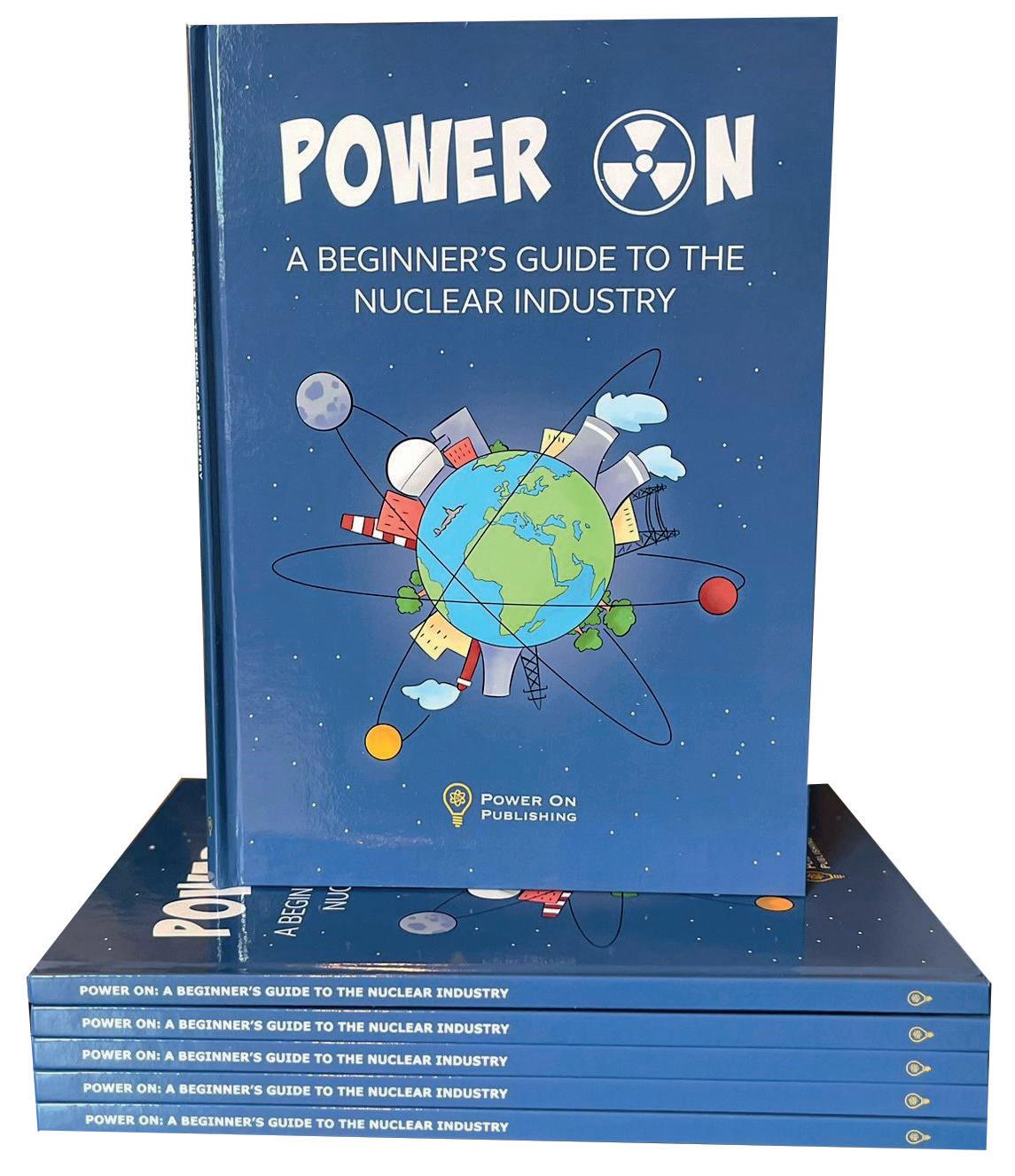
Working as a team we made it our vision is to make a career in the nuclear industry an aspiration for the next generation, regardless of background or academic interest. For this reason, our book includes multiple career-focused sections to showcase the
range of exciting career opportunities and pathways into nuclear. This includes Q&As with talented individuals working within our industry, as well as job descriptions linked to the nuclear technologies explored in the book’s pages.

Our book is available to purchase via our website (scan the QR code or visit poweronpublishing.co.uk) and at any in-person events Power On Publishing attend. Please check our social media to keep up to date with the events we are heading too next!

At Power On Publishing, we are keen to collaborate with you and your organisation, and in doing so broaden the reach and impact of our book. We are flexible in our approach to partnership and are happy to work with you to fulfil your requirements. Email poweronpublishing@mail.com to find out more about opportunities in your organisation!
Power On Publishing is proud to be in partnership with Bag Books, a small charity based in South West London that creates multi-sensory stories for people with severe or profound and multiple learning difficulties. They tell their stories using emotion, voice and interactive activities rather than words. Christie from Bag Books said, “I hope that Bag Books continues to grow and thrive so that our work can benefit the lives of as many people as possible and provide inclusive opportunities to those who need us the most.”
All profits from our business will be donated to this amazing cause, ensuring it continues to thrive.
A group of Nuclear Graduates have been busy working on a new educational resource aimed at young learners who are interested in nuclear and its importance in the climate.▲ Power On Publishing presenting at the YGN annual conference in 2022: (names from top left to top right) Jamie Scattergood, Matt Berry, Jacob Bie, Jasmine Mund, Leia Mouchous, Callum Evans, (bottom left) Alex Cunningham and Luke Taylor-King.
Nuclear has had a good spring. In my last column, I wrote about the urgency of the UK turning broad political support for nuclear into action. I listed six steps that we wanted to see, so let me set out the progress report here:
● Green labelling nuclear investment as sustainable: I will quote the Chancellor in his Budget speech “Subject to consultation, nuclear power will be classed as environmentally sustainable in our green taxonomy. That will give it access to the same investment incentives as renewable energy.”

● Launch of Great British Nuclear: GBN was launched this spring, as a resurrection of British Nuclear Fuels Limited, with the mandate to run a SMR down selection process this year, work with the Government on siting access, and consider the role of further large-scale nuclear, as well as the powers to form subsidiaries and joint ventures with the private sector for individual projects.
● Funding for DESNZ/GBN to get two projects to FID in the next Parliament: not committed and not ruled out
● A commitment to a programme approach to reactor deployment: let me quote again “The government is committed to a programme of new nuclear projects beyond Sizewell C, giving industry and investors the confidence they need to deliver projects at speed. The aim of GBN is to facilitate delivery of this programme of new nuclear projects.”
● Initiating negotiations on how we fund SMRs: not committed to yet.
● Planning reform, including the swift imposition of a Net Zero duty on regulators: an amendment to the Energy Bill to place a Net Zero duty on regulators passed the House of Lords, and there is an active discussion in Government about how to respond.
The Government took three of those six steps, it may take another one, and two it has not taken yet. By any measure, that is a great success for industry. We still need to see the consultation, but the green label for nuclear opens up a bigger pool of investors for our projects. A commitment to a programme suggests we have learned the lessons of past failures stopping and starting, toying and tinkering, but never repeating. The formation of Great British Nuclear, and in particular its empowerment to get involved with individual projects, augurs well.
Political pressure was the reason these steps have been taken. Our team played our part, helping to organise more than 100 Parliamentarians of all
parties to write to the Prime Minister to call for the green labelling of nuclear investment and meaningful powers for GBN. The arguments we and others have made to the Chancellor, the Prime Minister and the Government as a whole that nuclear is key to a sustainable, affordable and secure energy system have been compelling. The rhetorical and in-principle policy support for nuclear now has form and structure in a way that it has not had for decades.
The key now, is to have that new structure secure projects. The keen-eyed or cynical observers among you will have noted that the two steps to which the Government did not commit shared one key word funding. That is the way we get from organisations and technologies to projects, and that has to be our absolute priority now. Within that, there are four key aspects:
● The Government should confirm as soon as possible the capital structure for the Sizewell C project, including how it will fund its own stake in the project. Only when the capital structure is set will the team know which kinds of investors to target to secure a Final Investment Decision in 2024.
● The Government should offer a meaningful prize for winning the SMR competition. The winners should get access to a site, access to a funding model (either CfD or RAB) to raise investment, and the offer of a Government minority stake to pave the way to FID.
● The Government should spell out the conditions under which it will pursue further large-scale nuclear, including if it will allow plants built outside the UK to be used as reference plants for access to the Regulated Asset Base model funding.
○ Since the beginning of 2022, a new EPR, a new APR-1400, and a new AP1000 have all started generating power. The designs have been built, and they work. It has been the best spell for Western large-scale nuclear in 20 years, and we should take advantage.
● The Government should clarify if GBN will become a nuclear site licensee and operating company, and if not, how new projects will be developed.
All of these points are about securing projects a specific reactor built on a specific site by a specific company that will be operated by another specific company. That is the task ahead of us, and the NIA will be pushing as hard as ever to secure real substantive investment in our sector. As always, if you want to be a part of making this case, let me know at lincoln.hill@niauk.org the work goes on!
Projects, projects, projects—We have Great British Nuclear, now we need projects.